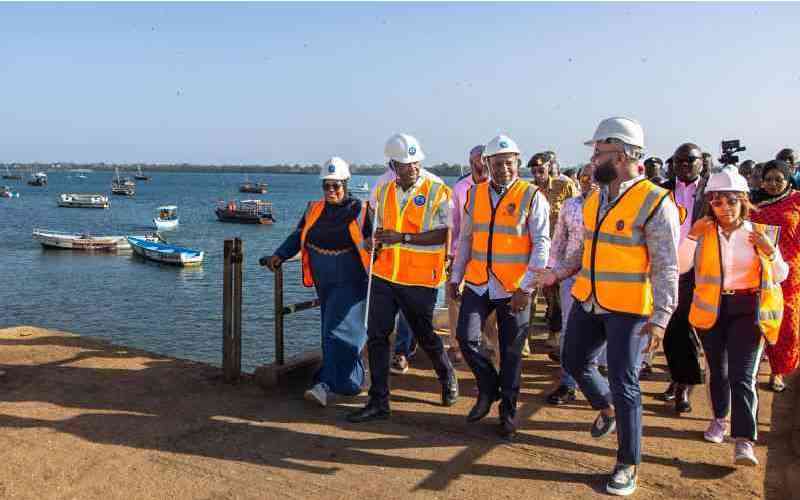The Sh10 billion Kenya Marine Fisheries and Socio-Economic Development Project (KEMFSED) has been hailed for transforming the livelihoods of coastal communities.
Now in its fourth year, the project is credited with creating over 30,000 jobs in fishing communities in the four coastal counties.
“The initiative has improved the income of coastal communities, created more than 30,000 new jobs across Mombasa, Kilifi, Kwale, and Lamu counties, and boosted local economic growth and development,” says Charles Ayoro, an economist and public affairs analyst.
Follow The Standard
channel
on WhatsApp
Key milestones include the revival of the Liwatoni Fishing Port in Mombasa and the construction of a modern fish processing plant in Lamu town.
According to Ayoro, fisheries are vital for food security, sustainable livelihoods, and the preservation of cultural heritage among coastal communities.
However, despite the rich marine ecosystem, fisheries from Kenya’s 600-kilometre coastline account for only about five per cent of the country’s total fish production.
Ayoro attributes this underperformance to financial, technological, and infrastructural challenges. Most artisanal fishers are confined to nearshore areas between the beach and the reef due to limited equipment.
The World Bank reports that Kenya’s marine fisheries sector supports about 35,000 fishermen, including 24,000 artisanal and small-scale fishers.
Yet, for decades, coastal communities have suffered economic marginalisation, conditions that have sometimes fuelled youth unemployment, crime, and even recruitment into violent extremism.
“Perceived historical injustices linked to land, poor education, religious influences, unemployment, and drug abuse have pushed some youth into crime and violence at the coast,” Ayoro explains. “But revamping the fisheries sector has offered alternatives for many young people and contributed to the growth of the blue economy,” explained Ayoro.
He noted that the KEMFSED project has come at a critical time when millions of unemployed youth are seeking opportunities.
Coastal county governments have also integrated the blue economy into their development plans as part of efforts to tackle marginalisation, poverty, ethnic tensions, and political violence.
Ayoro urged the government to partner with the private sector to establish similar initiatives in other fishing regions, including around Lake Victoria.
“Such a project would create jobs for young people and help reduce spiralling crime and insecurity, especially in Kisumu and other regions with a similar potential,” he added.
Follow The Standard
channel
on WhatsApp
The Sh10 billion Kenya Marine Fisheries and Socio-Economic Development Project (KEMFSED) has been hailed for transforming the livelihoods of coastal communities.
Now in its fourth year, the project is credited with creating over 30,000 jobs in fishing communities in the four coastal counties.
“The initiative has improved the income of coastal communities, created more than 30,000 new jobs across Mombasa, Kilifi, Kwale, and Lamu counties, and boosted local economic growth and development,” says Charles Ayoro, an economist and public affairs analyst.
Follow The Standard
channel
on WhatsApp
Key milestones include
the revival of the Liwatoni Fishing Port in Mombasa and the construction of a modern fish processing plant in Lamu town.
According to Ayoro, fisheries are vital for food security, sustainable livelihoods, and the preservation of cultural heritage among coastal communities.
However, despite the rich marine ecosystem, fisheries from Kenya’s 600-kilometre coastline account for only about five per cent of the country’s total fish production.
Ayoro attributes this underperformance to financial, technological, and infrastructural challenges. Most artisanal fishers are confined to nearshore areas between the beach and the reef due to limited equipment.
The World Bank reports that Kenya’s marine fisheries sector supports about 35,000 fishermen, including 24,000 artisanal and small-scale fishers.
Yet, for decades, coastal communities have suffered economic marginalisation, conditions that have sometimes fuelled youth unemployment, crime, and even recruitment into violent extremism.
“Perceived historical
injustices linked to land, poor education, religious influences, unemployment, and drug abuse have pushed some youth into crime and violence at the coast,” Ayoro explains. “But revamping the fisheries sector has offered alternatives for many young people and contributed to the growth of the blue economy,” explained Ayoro.
He noted that the KEMFSED project has come at a critical time when millions of unemployed youth are seeking opportunities.
Coastal county governments
have also integrated the blue economy into their development plans as part of efforts to tackle marginalisation, poverty, ethnic tensions, and political violence.
Ayoro urged the government to partner with the private sector to establish similar initiatives in other fishing regions, including around Lake Victoria.
“Such a project would create jobs for young people and help reduce spiralling crime and insecurity, especially in Kisumu and other regions with a similar potential,” he added.
Stay informed. Subscribe to our newsletter
Follow The Standard
channel
on WhatsApp
By Ayoki Onyango
